METAPHYSICAL PROPERTIES OF THE STONES USED IN DRUKMO MALAS
A survey of the various expositors of metaphysical properties of stones reveals little agreement among them, yet the stones do have distinctive, scientifically determined compositions and qualities. In this day and age of a world out of balance and suffering from pollution, warfare and disease, perhaps we can use whatever help we can get to reconnect to the wisdom of the earth. Focusing upon the stones used in Drukmo Malas, we provide a sampling of opinion from these practitioners of the art of stones.
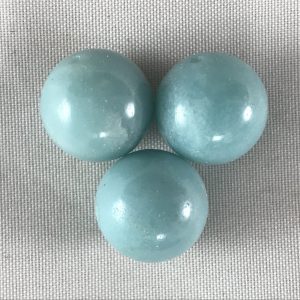
amazonite
– A form of feldspar comprised of potassium aluminum silicate, named after large deposits found along the Amazon River. Four thousand year old jewelry has been found incorporating amazonite. The seventh chapter of the Egyptian Book of the Dead was engraved on amazonite, and an amazonite scarab ring was found among Tutankhamen’s treasures. Contemporary thought associates this stone with communication and harmony and with the 4th (Heart) and 5th (Throat) chakras. This stone allows the energy of the heart to be expressed through communication
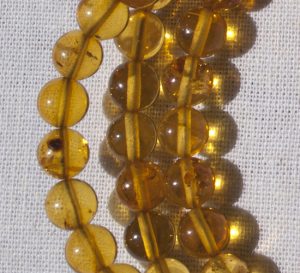
Amber Beads
– An organic material composed of fossilized pine resin between 30 to 60 million years old. In ancient Greek the word for amber was also the name of the sun: electron. When amber is rubbed, it forms an electronic charge; from this is derived our word “electricity.” The finest amber comes from the Baltic region. The healing properties of amber are particularly associated with the warming energy of the sun and the organic life force of trees. It is considered to be one of the most wholesome and warming of all the gemstones. Amber is thought to take in negative energy and transform it into clear, pure energy. It also is a very “ratna” stone, in its color and qualities, and assists in amplifying prosperity.
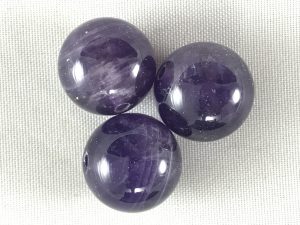
amethyst beads
– A member of the quartz family with the addition of iron and aluminum. It is the birthstone for the month of February. Its chief qualities are those of enhancing spiritual awareness, transformation, purification and cleansing. It is connected with the 6th and 7th chakras, the Third Eye and the Crown.
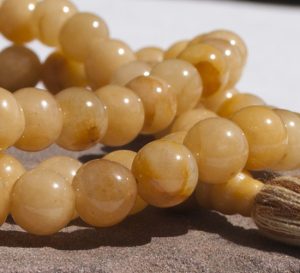
Aragon Beads
– Is a form of calcium carbonate named after the Spanish river Aragon. It is often found near thermal springs. Because of its high calcium content it promotes the formation of healthy skin, bones and tissue. It also strengthens the immune system. Aragonite is connected with the 2nd or Sacral chakra.

Aventurine
– A member of the quartz family. It may be green, red or blue depending on other combining minerals. Green aventurine is colored by the addition of fuchsite particles. Metaphysical thought associates this stone with vitality, growth, confidence and good luck. It is linked to the 4th or Heart chakra and therefore its energy is peaceful, compassionate, nurturing and healing. Its healing influences affect the heart, lungs and immune system.

black-onyx
– A variety of chalcedony and a member of the quartz family. It is a stone of inner strength and discipline, protection and clearing obstacles. Onyx is connected with the 1st (Root) and 3rd (Solar Plexus) chakras. It enhances one’s ability to carry out and complete activities. It is considered to be a very powerful stone.
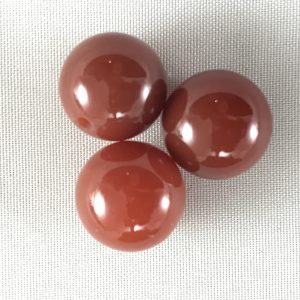
carnelian beads
– A type of chalcedony and member of the quartz family in which its particles are arranged in fibrous layers. Unchanged since ancient times when carnelian was worn into battle to promote courage, it is still considered to build courage, confidence and power. It is connected with the 1st, 2nd, and 3rd chakras, the Root, Creative/Sexual, and Solar Plexus centers of the body. Its healing energy is thought to affect the circulatory and reproductive systems in particular. It is the astrological stone of Virgo.
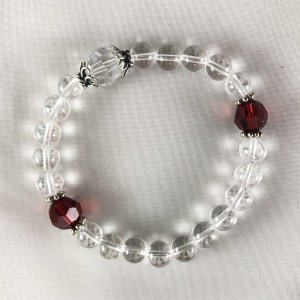
Rock Crystal…
– Its metaphysical properties are considered to be those of amplifying one’s intentions, magnifying energy, clearing and cleansing, and healing. It is energetically connected and of benefit to all the chakras. It is considered the most versatile stone in the mineral kingdom, but is particularly used for enhancing and bringing clarity to one’s spiritual path.
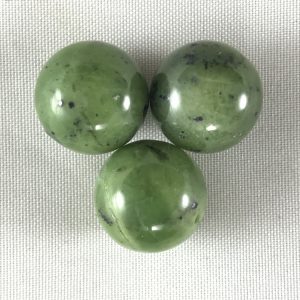
canadian-jade
– two minerals share this name: nephrite and jadeite, both of which have been prized for their incredible toughness and strength. Many world cultures have used jade for axes, hammers and ritual implements. This stone is associated with abundance, health and longevity and with the 4th (Heart) chakra. Its energies promote well-being and balance and foster wholesome growth of the life-force.
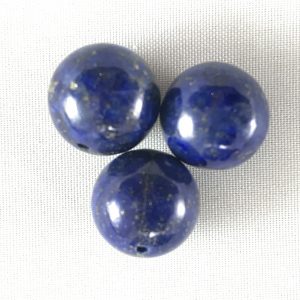
lapis
– a sodium aluminum silicate with sulfur, chlorine and hydroxyl, and inclusions of pyrite and white calcite. It is said to calm the mind, develop intuition, meditation and wisdom. In ancient Egypt lapis was ground and placed upon the eyes of pharaohs after death so they could see the doors of entrance for the next life. The tomb of Tutankhamen is richly inlaid with lapis. Catherine the Great decorated a room in her palace with lapis walls, fireplaces, doors, and mirror frames. The blue in some old and exceedingly fine Tibetan tangkhas (scroll paintings) of meditational deities was made of ground-up lapis, and the Medicine Buddha, the embodiment of healing energy, is described to be the blue of lapis lazuli. All of these historical associations and uses have made lapis a pre-eminent stone of royalty and wisdom. Lapis is connected with the 5th and 6th chakras.
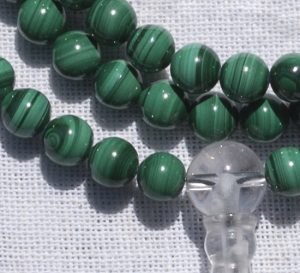
Malachite Beads
– a copper carbonate mineral. Like lapis, malachite was a popular stone in Egypt and used extensively in jewelry, ornamentation, and eye shadow. Some consider it the most important stone for protection against negativity. It works with the heart energy to promote emotional balance. Its energy relates to the 3rd and 4th chakras.
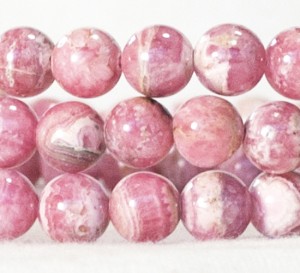
Rhodochrosite beads
– a manganese carbonate. This stone is strongly associated with the heart and its energies of love and compassion. Some call it “the stone of love and balance,” because of the soothing warmth of its energy. It is also thought to influence creativity and intuition. It is linked to the Heart and Solar Plexus chakras.

rose-quartz
– a member of the quartz family. Like all of the quartzes, this stone is a great channeller and transmitter. Its pink color builds upon this and makes it the stone of unconditional love, a love without boundaries or conditions of any kind. It embodies the energy of the Heart chakra and is often used for assisting meditation practices of compassion as well as for connecting with the great body of the mother earth.
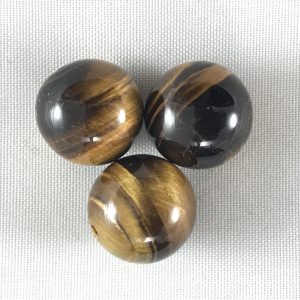
tiger-eye
– a fibrous form of quartz. The fine, similarly oriented fibrous inclusions produce the lustrous reflection of light called “chatoyancy,” or cats eye effect. This stone is associated with balance (especially between yin and yang energies), practicality, strength and physical action. It is another stone good for protection as its balancing capabilities neutralize negativity. It is thought to stimulate the 1st, 2nd and 3rd chakras.

turquoise-scaled
– a copper aluminum silicate. Blue tones are caused by copper, while green shades are caused by inclusion of iron. Turquoise has perhaps the oldest history of any stone, dating back some 5000 years to its mining in Iraq. For a thousand years, the stone has been used by the indigenous peoples of North America. The Navajo used it to bring rain; the Zuni used it as protection against evil; and the Apache thought it enhanced their weapons’ accuracy. In Tibet it is a stone of action and protection. Metaphysical thought considers it a stone to promote communication and spiritual growth. It is also thought to have considerable healing properties. It is thought to align and cleanse all the chakras, but is efficacious in particular to the Throat chakra.
SOURCES:
Randall and Vicki Baer, Windows of Light: Quartz Crystals and Self-Transformation, Harper & Row, 1984.
Robert Simmons & Naisha Ahsian, The Book of Stones: Who they Are and What They Teach, Heaven & Earth Publishing, 2005.
Jaroslav Bauer and Vladimir Bouska, A Guide in Color to Precious and Semiprecious Stones, Chartwell Books, 1989.
Paul E. Desautels, The Mineral Kingdom, Grosset & Dunlap, 1968.
Dr. Flora Peschek-Bohmer and Gisela Schreiber, Healing Crystals and Gemstones, Konecky & Konecky, 2002.


